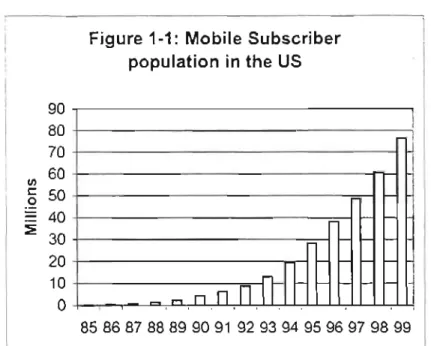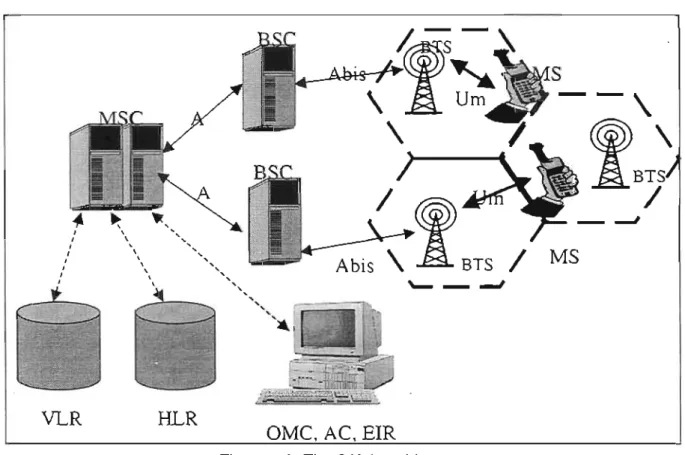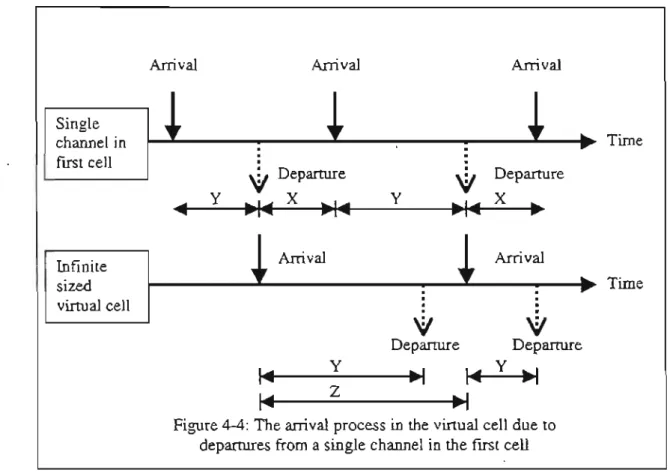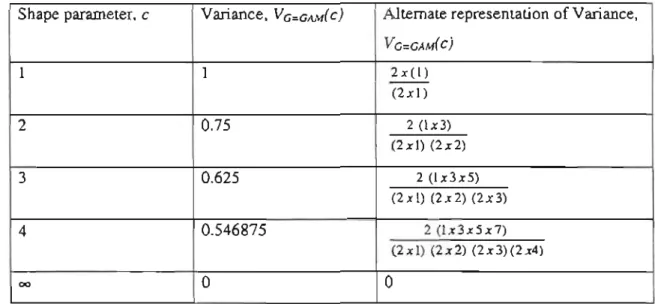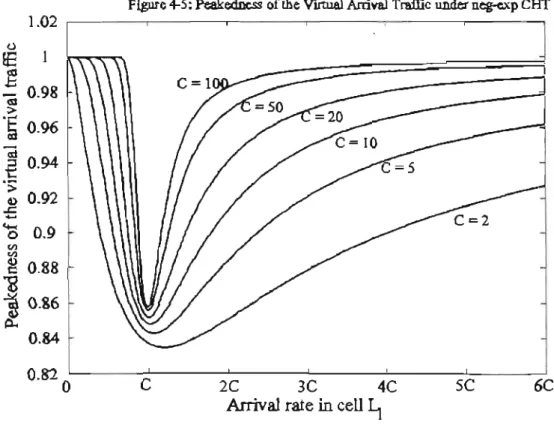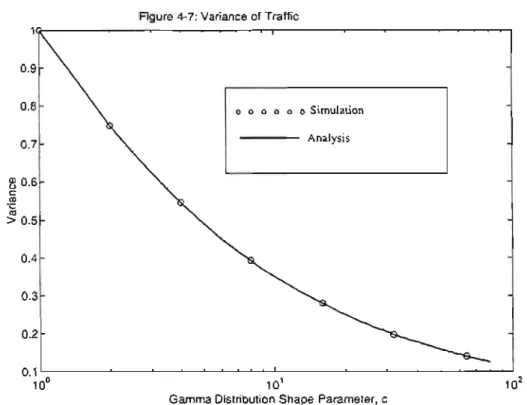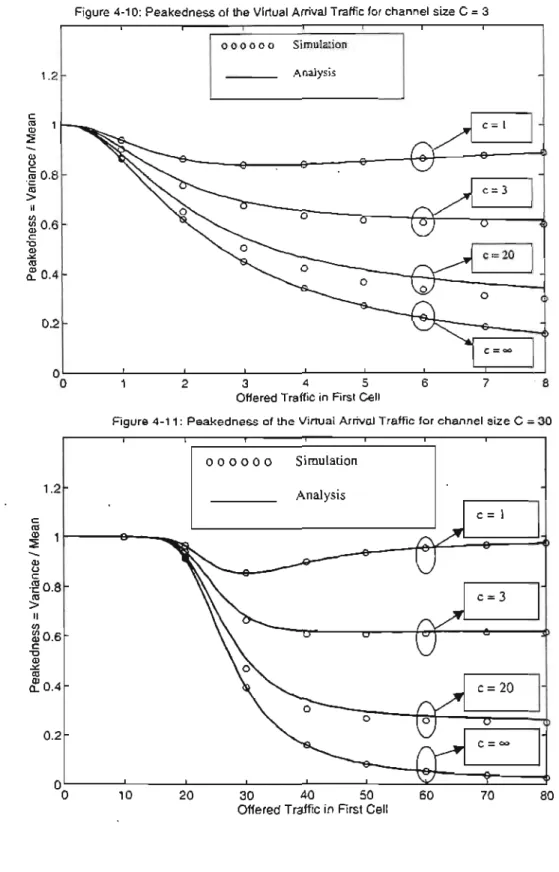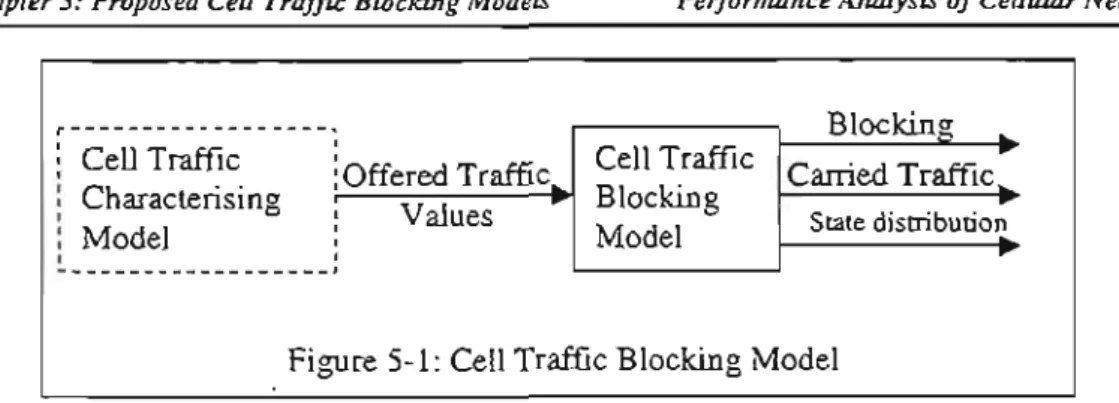3- 18 3.6 Performance Analysis Algorithm by Long-Rong Hu and Rappaport for the Multiple Hierarchical Cellular Overlays. Channel dwell time distribution under arbitrary cell dwell times Performance analysis of practical cellular networks where cell dwell time distributions are unknown.
No figures
No figures
GSM system Architecture
OMC AC EIR
Cell dwell times and Channel holding times
There is no difference between the dwell time on the cell for new and manual calls. In a cell traffic characterization model, it can be shown that the average handover arrival rate is ~ in order.
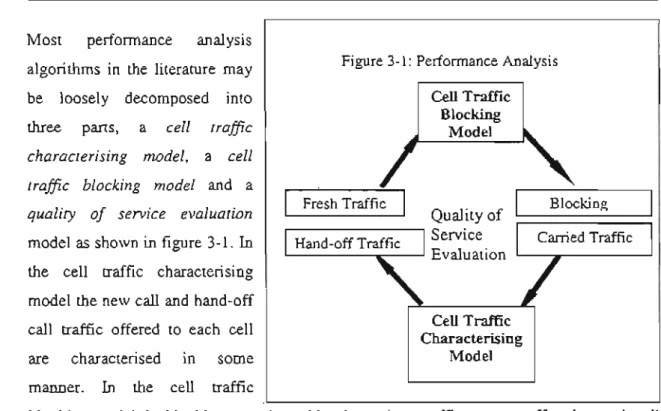
Summary
The average offered traffic in the first cell due to the Poisson arrival process is A = A EfT). When handover probability QFl, each call in the first cell is offered to the virtual cell. By classical definition (14), the offered traffic distribution for the virtual arrival traffic offered from the first cell to the virtual cell is simply the transported traffic distribution in the virtual cell of infinite size.
The virtual arrival traffic in the virtual cell is actually the cumulative effect of these C-independent GIGloo queuing systems. Similarly, the variance is 1/GEN of the virtual arrival traffic served by the first cell to the virtual cell, under the infinite arrival rate in the first cell and the random service time IXif j(t),. Using this result in equation 4.44, the variance of the virtual arrival traffic is V-DT.NG under det-neg channel holding times and in the limit A~:.
Let us now consider the variance of the virtual arrival traffic under finite arrival rates in the first cell, channel hold times det-neg distributed with mean 11Ji and probability parameter p where OSpS!. In the absence of exact results, we propose the above expression as a suitable approximation for the variance V DT.NG of the virtual arrival traffic presented by the first cell to the virtual cell under det-neg channel holding time distributions and finite arrival rates. In the results section, we will illustrate the accuracy of the above approximate expression for the variance of the virtual arrival traffic presented by the first cell to the virtual cell under gamma channel hold time distributions.
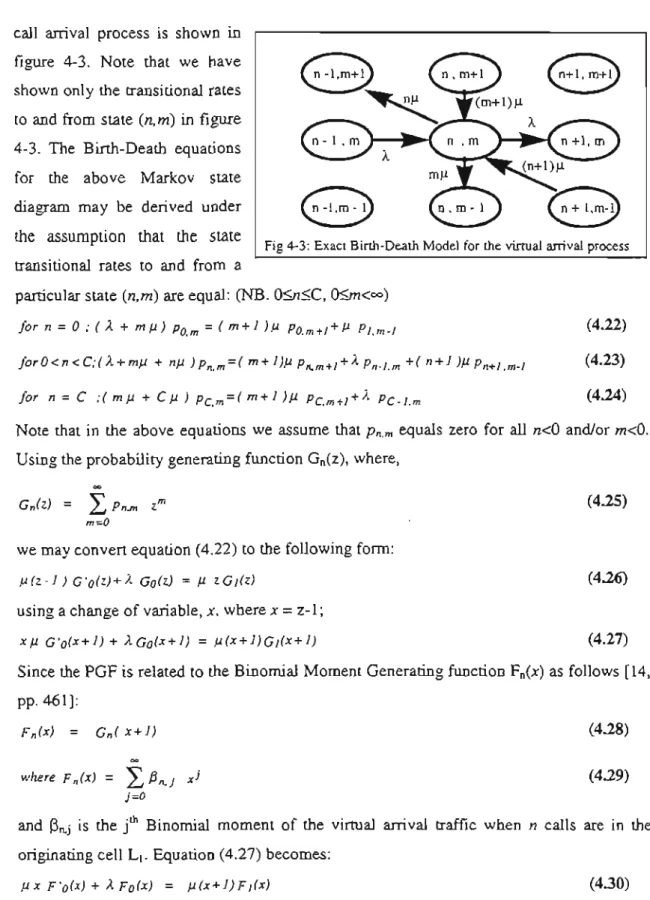
RESULTS
The vertical axis represents the peak virtual arrival traffic and the horizontal axis represents the arrival rate at cell L as a multiple of the channel size C. The virtual arrival traffic is a smooth process for a large range of channel sizes and arrival rates for times of holding negative exponential channels. The peak area of the virtual arrival traffic, for the different channel sizes examined, has a minimum approximately in the region where the delivered traffic A=Alj.I.=C.
In our mobile traffic characterization model, we have shown that the virtual arrival traffic is fundamental 10 by accounting for the delivery traffic. Provided we know the mean and variance of the virtual arrival traffic, we are able to determine the mean and variance of each delivery arrival traffic where the delivery probability QI1 51 (equations 4.19 & 4.20). In this section, we evaluate the accuracy of our expression for the variance of the vinual arrival traffic delivered from the first cell to the virtual cell (in Figure 4-2b) in terms of det-neg as well as gamma channel hold times.
For the two different channel sizes we considered, the peak of the virtual incoming traffic as determined by our quadratic approximation (Equation 4.50) matches the simulation results very well compared to the linear approximation. The remarkable accuracy of the quadratic approximation for the variance of the virtual arrival traffic (Equation 4.50) is a proof of the validity of the asymptotic analysis we used, where we considered the behavior of the virtual cell system when the arrival rate is A. For the two different channel sizes we considered, the peak value of vinual arrival traffic as determined by our analysis (Equation 4.54) agrees fairly well with the simulation results.
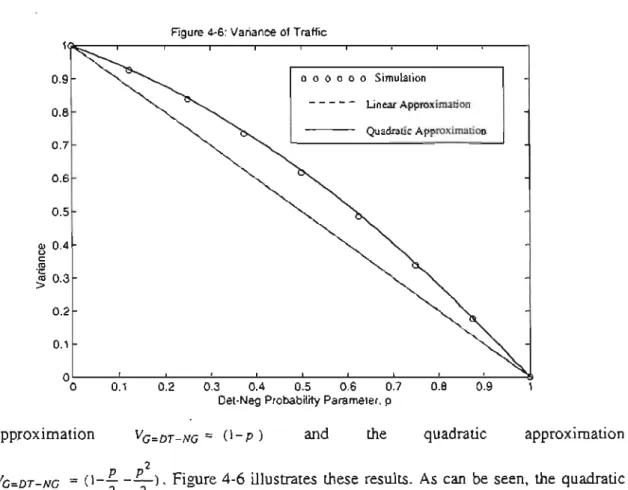
CHAPTERS
Results
Then, with our extensions of Delbrouck's model and the model of Sanders et al. found that I was being blocked by both new and committed traffic flows in the other cell. For the congestion that occurs in the handover process, the models of Sanders et al and Delbrouck were better than the one-moment model compared to the simulation results. For the congestion experienced in the handover process, the Sanders et al. model and the Delbrouck model performed better than the single-moment model compared to the simulation results—the single-moment method had a worst-case error of 37% for underload conditions.
For the congestion experienced by the transfer process, Sanders et al.'s model and Delbrouck's models outperformed the single-moment model compared to the simulation results - the worst-case error was 121% for the single-moment method. For the congestion experienced by the transfer process, Sanders et al.'s model and Delbrouck's models significantly outperformed the single-moment model compared to the simulation results - the single-moment method had a worst-case error of 180% for underload. For the congestion experienced by the transfer process, Sanders et al.'s model and Delbrouck's models outperformed the single-moment model compared to the simulation results - the worst-case error was 79% for the single-moment method.
For the congestion experienced by the transfer process on arrival, Sanders et al.'s model and Delbrouck's models significantly outperformed the single-moment model when comparing the simulation results - the single-moment method. We assume that the mean and variance of the transferred traffic flows are obtained from the previous iteration. Consequently, the mean Mho and variance Vho of handoff traffic offered by the original cell L to neighbor j is:
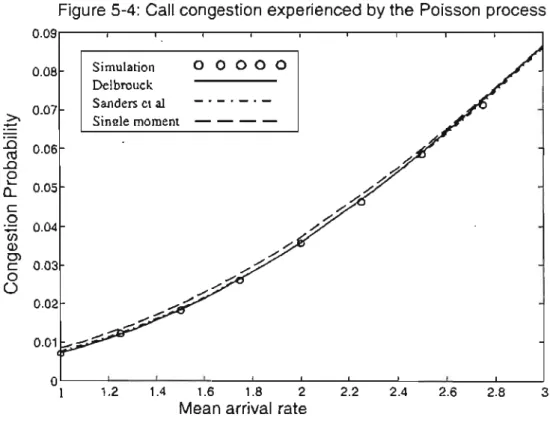
Results
In our analysis, we use the simple negative-exponential distribution as the candidate time-division channel. The channel holding time from the mobility model of Del Re et al. has the Erlang number of 0.7. Moreover, Zonoozi and Dassanayake [18] indicate that the channel holding time determined by their mobility model is well approximated by the negative exponential distribution.
In practical networks, it is very unlikely that the channel hold times are exactly neg- or gamma-distributed. We consider two similar network scenarios for the det-neg and gamma channel holding time distributions. The reason for this is that the classica1 method assumes that handover call arrivals are Poisson and that channel holding times are negative exponential.
However, the classical analysis assumes that delivery arrivals are Poisson and that channel holding times are negative exponentially distributed. On the other hand, the proposed analysis tries to capture the actual attributes of the handover traffic using a two-moment representation and tries to model the channel holding time distributions more accurately. Mobility modeling is used in performance analysis of cellular networks to derive cell dwell time distributions and channel hold time distributions.
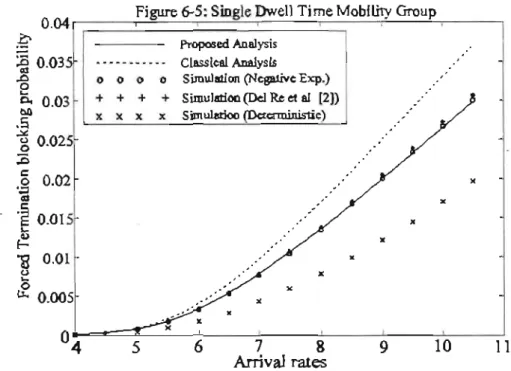
Mobility modelling in highway networks
We assume that handover calls can be offered by the cohabiting network to the highway network when vehicles enter the highway via an on-ramp. Due to the non-blocking environment in the cohabiting network, we assume that the handoff calls offered by the cohabiting network to the highway network form a Poisson process. The exit process (to the cohabiting network) can simply be regarded as a subset of the transfer process.
We then assume that the dwell times of new calling cells and handover times of calling cells in a cell have arbitrary probability density functions (pdfs), fit) and f1l.t), respectively. The number of new calls made No over time TM1 •. The number of completed new calls requesting a handover of NCC.H over time TM1•. Over time, the number of drop-off calls became TMI. The reason for this is that the proposed analysis models the survival process as a general arrival process, while the existing method models it as Poisson.
The cell traffic characterization model is used to determine the mean and variance of the handoff traffic that a cell offers to its neighbor. 6 is a performance analysis model based on new Poisson calls, generalized transfer calls and appropriate channel holding times, such as the negative exponential distribution, the det-neg distribution and the gamma distribution. The single-moment method uses Poisson hand-off arrivals and negative exponential service time distributions.
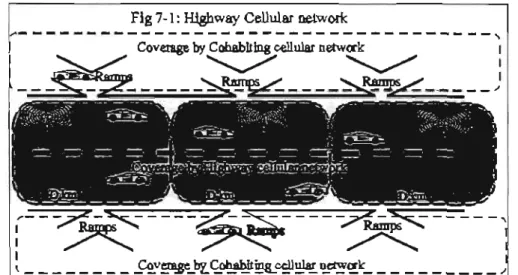
APPENDIX A
Index) represents the stage of the call arrival process and therefore can have the values 1' or 2. The index k represents the number of calls in stage 1 of their two-stage Erlangian service process, and the index m represents the number of calls in stage 2 of their two-stage Erlangian service process. The equations of state for the above system can be derived under the assumptions that the state transition rates to and from a given state U,k,m] are equal.
Substituting (A.9) into equations (A.IO-A.II) and equating coefficients with equal powers of x and w yields several equations relating the different binomial moments.
Nanda "Channel Management in MicrocellVMacrocell Cellular Radio Systems" IEEE Transaction on Vehicle Technology, vo145, no. Stewart, “Analysis of circuit-switched networks using original office control with leakage,” IEEE Transactions on Communications, pp754-765,. 17] R.Guerin, "Channel Occupancy Time Distribution in a Cellular Radio System", IEEE Transactions on Vehicle Technology, VT -35, no.
Massey og W Whin, "Tramc Models for Wireless Communication Networks" IEEE Journal on Selected Areas in Communications, bind 12, nr. Fuhrmann, "Teletrafikmodellering og analyse af fleksible hierarkiske cellulære netværk med hastighedsfølsom overdragelsesstrategi" IEEE Journal on Selected Areas in Communications, pp vo115, nr. Rappaport, "A model of Teletraffic Performance and Channel Holde Time characterization in Wireless Cellular Communication with General Session and Dwell Time Distributions," IEEE Journal on Selected Areas in Communications, Vol 16, No.
29] Rappaport The multiple call hand-off problem in high capacity cellular communication systems," IEEE Transactions in Vehicular Technology. Jabbari, "A Measurement-Based Prioritization Scheme for Handovers in Mobile Cellular Networks", IEEE Journal on Selected Areas in Communications. 441 Akinpelu, ''The Congestion Performance of Engineering Networks with Nonhierarchical and Hierarchical Routing, ITe10, Montreal L. E. N. Delbrouck, "A unified approximate Evaluation of Congestion Functions for Smooth and Peaky Traffic", IEEE Transaction on Communications, Volume COM-29, No. 2 , pp. 85-91, February 1981.
